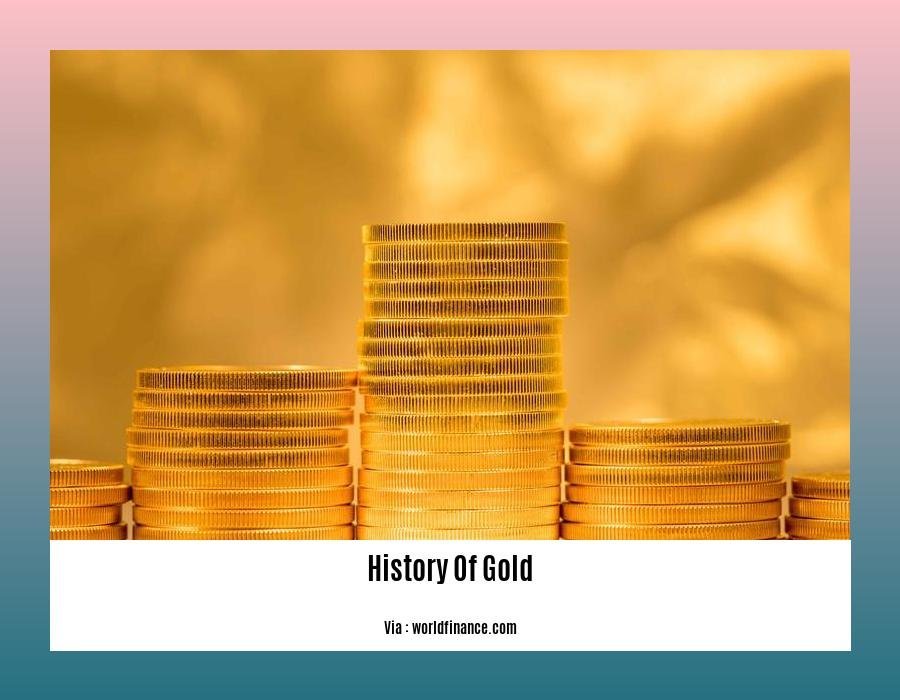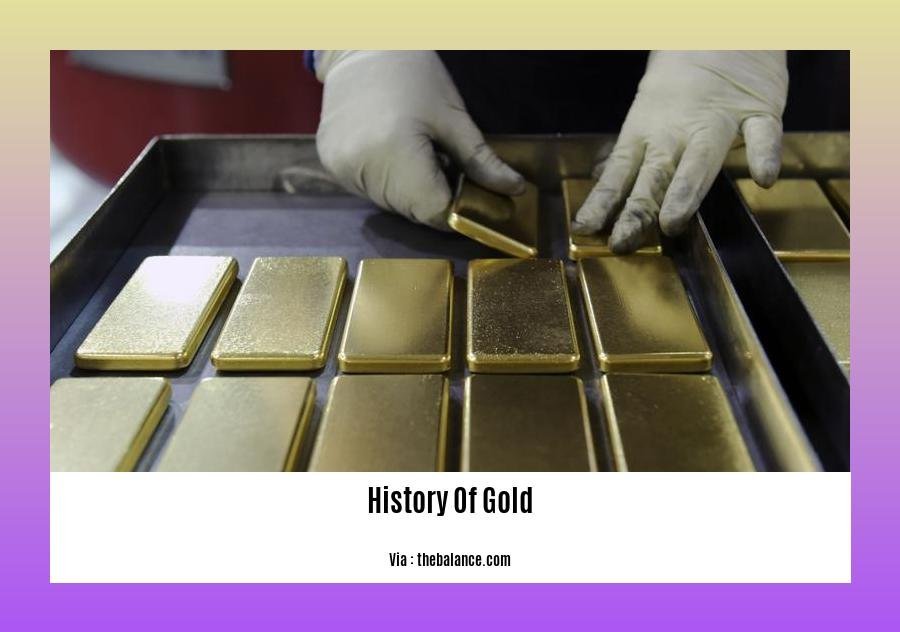– The Ancient Roots and Enduring Legacy: A Journey into the History of Gold – From its humble beginnings as a symbol of power to its enduring role as a currency and investment, gold has left an indelible mark on civilizations throughout history. Join us as we embark on a captivating journey into the ancient roots and enduring legacy of this precious metal.
Key Takeaways:
- Gold’s history spans centuries, with early mining in the Mediterranean and Middle East.
- Gold has been used as a versatile material for currency, jewelry, art, and decoration.
- Gold has played pivotal roles in historical events, including the rule of Egyptian pharaohs and the Gold Rush.
- Gold remains a valuable commodity and investment option in modern times.
History of Gold
Delving into the history of gold is akin to unearthing a treasure trove of stories and events that have shaped human civilization. Its lustrous allure has captivated societies for millennia, its golden thread weaving through the tapestry of time.
Gold first emerged in ancient times, its gleam tempting early civilizations in the Mediterranean and Middle East to mine it for its inherent beauty and rarity. The pharaohs of Egypt, known for their lavish opulence, adorned themselves with golden artifacts and jewelry, symbolizing their divine power.
As civilizations evolved, so too did gold’s significance. It played a pivotal role in the voyages of Columbus, who sought to find El Dorado, the legendary city of gold. The subsequent Gold Rush, in the 19th century, saw thousands of prospectors flock to California and the Yukon, driven by the allure of untold wealth.
Throughout its history, gold’s versatility has been remarkable. It has served as currency, facilitating trade and commerce, as well as a symbol of status and prestige. Its intrinsic value has made it a valuable investment option, weathering economic storms and maintaining its allure over time.
Today, gold continues to captivate us, its history entwined with our own. It remains a cherished commodity, used in jewelry, décor, and art, while its role in global finance and investment persists.
Gold’s history is a testament to its enduring appeal, its significance transcending time and culture. It is a timeless treasure that continues to ignite our imagination and fascinate us with its enduring legacy.
Explore the ancient uses and mining of gold, which spans millennia and played a pivotal role in shaping civilizations. Discover the allure of gold rushes, where dreams of wealth propelled countless individuals on treacherous journeys. Delve into gold’s role in the global economy, from its use as currency to its impact on international trade and power dynamics.
History Of Gold In The World

Gold is an enduringly fascinating metal that has shaped the course of human history. From ancient times to present, it has held significant value in civilizations around the world.
Gold’s Role as Currency
Historically, gold has been the backbone of monetary systems. Its inherent value and scarcity made it an ideal medium of exchange. In ancient Egypt, gold was used to pay for goods and services. Later, the Roman Empire adopted a gold standard, helping to stabilize the economy.
The Gold Standard Era
The 19th and 20th centuries witnessed the heyday of the gold standard. Developed economies adopted a global monetary system pegged to gold. This era brought stability and prevented excessive inflation. However, the Great Depression led to a widespread abandonment of the gold standard.
Key Takeaways:
- Gold has served as currency for millennia, providing stability and facilitating trade.
- The Gold Standard era promoted monetary stability and reinforced the credibility of currencies.
- Historical events have significantly influenced the role and value of gold throughout time.
Sources:
History of Gold Mining
Gold has captivated human civilizations for millennia. History of Gold Mining uncovers the ancient practices and enduring techniques that have shaped the industry and left lasting legacies. Join us as we explore the evolution of gold mining.
Earliest Origins
The earliest evidence of gold mining dates back to around 4000 BC in Egypt and Mesopotamia. Gold was highly prized for its malleability and luster, making it an ideal material for ornaments and religious objects. By 3000 BC, gold rings were widely used as a form of payment, demonstrating its value as a medium of exchange.
Ancient Techniques
Ancient gold miners employed a variety of techniques to extract gold from the earth. Placer mining involved panning and sluicing to separate gold particles from river sediments. Hard rock mining required more advanced methods, such as underground tunneling and the use of fire to soften rocks.
Major Gold Rush
The California Gold Rush of 1848 marked a pivotal moment in the history of gold mining. The discovery of gold in the Sierra Nevada Mountains sparked a massive influx of miners, transforming California into a booming frontier state. The rush introduced new technologies and techniques, such as hydraulic mining and the use of stamp mills to crush ore.
Modern Mining
Today, gold mining is a highly industrialized process that employs advanced machinery and technologies. Open-pit mining involves removing large amounts of overburden to expose gold-bearing rock. Underground mining, including block caving and longwall mining, is used for deeper deposits.
Legacy and Impact
Gold mining has had a profound impact on human history. It has fueled economic growth, financed empires, and inspired countless legends and stories. From the opulent treasures of ancient Egypt to the California Gold Rush, gold has left an enduring legacy on our world.
Key Takeaways:
- Gold mining dates back to ancient times, with early practices in Egypt and Mesopotamia.
- Early mining techniques included placer mining and hard rock mining.
- The California Gold Rush revolutionized the industry and introduced new technologies.
- Modern gold mining is a highly industrialized process that employs advanced machinery.
- Gold mining has played a significant role in human history, influencing economics, culture, and society.
Relevant URL Source:
- Gold Mining – Wikipedia
- The History of Gold Mining
FAQ
Q1: How was gold discovered?
A1: Gold was initially discovered in its native form in alluvial deposits, where it was extracted from riverbeds.
Q2: What factors contributed to the widespread use of gold as currency?
A2: Gold’s intrinsic value, durability, and scarcity made it a reliable medium of exchange, facilitating trade and commerce.
Q3: Why did the United States abandon the gold standard?
A3: The abandonment of the gold standard was driven by several factors, including the need for monetary flexibility during times of economic crisis.
Q4: What is the significance of the California Gold Rush in the history of gold mining?
A4: The California Gold Rush of 1848 led to a significant increase in gold production, transforming California and contributing to the growth of the United States.
Q5: What are some of the ethical and environmental concerns associated with modern gold mining practices?
A5: Environmental degradation, displacement of local communities, and labor exploitation are among the ethical and environmental concerns raised by contemporary gold mining operations.
- China II Review: Delicious Food & Speedy Service - April 17, 2025
- Understand Virginia’s Flag: History & Debate - April 17, 2025
- Explore Long Island’s Map: Unique Regions & Insights - April 17, 2025
















